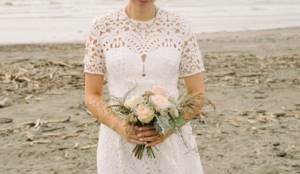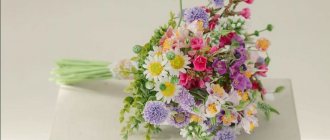Modern florists delight girls with a wide variety of wedding bouquet shapes. To complete and harmonize the image, it is important to find an option that can highlight your individuality. A cascading bridal bouquet looks luxurious and elegant, capable of highlighting the overall style of the event and drawing attention to your impeccable image.
The Svadebka.ws portal invites you to take a closer look at the bride’s cascading bouquet, find out the features of the composition and its design options. Our tips and photos will help you choose the perfect bouquet that will succinctly fit into the overall atmosphere of the celebration and add uniqueness and sophistication to your image.
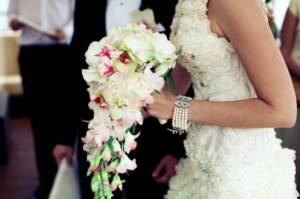
Features of a cascading bouquet
Cascading bouquets are very popular among fashionable florists and brides. They stand out among other types by their external splendor, sophistication and solemnity. In addition, the cascade - the form in which bouquets of this type are made - fits perfectly with almost any model of wedding dress. However, when choosing a cascading bouquet, you need to take into account all the subtleties: its price, wedding style, as well as the possibility of creating a harmonious combination with the image of the bride.
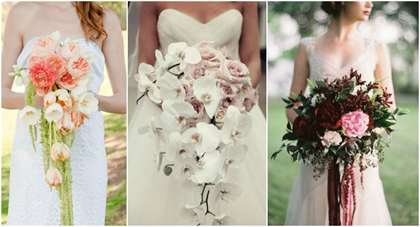
A cascading bouquet is a composition of flowers, the shape of which is a combination of a circle and a triangle. It can be created strictly according to proportions, while the bouquet will have a classic solemn look, or it can look more airy, introducing a feeling of slight negligence. The most romantic and tender bouquets will be those in pastel colors. .
Editor's choice: Beauty bachelorette party scenario: organizing and holding a fun party
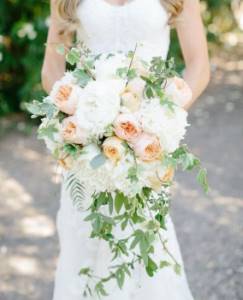
A bridal bouquet should look natural (or consist of fresh flowers), and it must be light, comfortable and durable. A girl should feel comfortable with this accessory.
The arrangement of flowers in a cascading bouquet can be very diverse: lines, chaotic or combined into groups. The appropriate option is selected in accordance with the preferences of the bride or the advice of an experienced florist who will help create a composition that will suit the festive look.
What flowers are used?
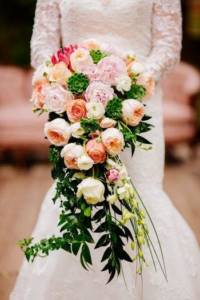
Florists try to diversify the shape of the cascade as much as possible. Many different plants are used for this. But there are still those that are considered ideal for creating a cascading composition.
They hold their shape well and fit harmoniously into the overall picture:
- lilies - have a voluminous inflorescence, which allows them to be used only in small quantities. The flower itself is distinguished by the special pride and royalty that emanates from it;
- Roses are a classic and traditional flower plant that can be used in any bouquet. Traditionally, roses are needed for the top part, from which they form a kind of circle;
- orchids are an exotic plant with delicate inflorescences. Their distinctive feature is their original color. As a rule, it consists of several tones. For example, there is a colorful and rich yellow color inside, and a muted, calm shade on the sides;
- tulips are a spring flower that is associated with the arrival of warmth and sun. The plant is characterized by the fact that it has several subspecies and varieties.
- peonies;
- sunflowers;
- daisies;
- eustoma;
- callas;
- freesia.
The flower arrangement itself can also include wild plants, which will give the image a special color of simplicity and beauty.
Who would like a cascading bouquet?
When choosing a wedding bouquet, you should pay attention to several factors.
- Bride's height. This type of accessory is perfect for tall brides with a slender figure. At the same time, short girls who choose a cascading bouquet will visually reduce their height. Therefore, it is better for short brides to refrain from purchasing such an accessory. But if your soul is drawn to it, then you should pay attention to options that are not too long.
- Combination of an accessory with a dress. A cascading bouquet does not suit short wedding dresses, but long dresses look great with it. The most successful combinations with this accessory are white A-line and straight-cut models, as well as options with a train, with a fluffy skirt and dresses in the Greek style.
- Girls who have chosen the “Princess” look are recommended to pay attention to cascading bouquets without decorative elements. And discreet and elegant dresses will go perfectly with a richly decorated accessory.
Editor's choice: How to wear an evil eye pin to protect yourself from the evil eye
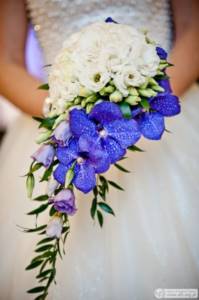
Assembly options
Florists have several ways to assemble bouquets. You can’t just gather flowers and greenery in an armful, tie it with twine and wrap it in oilcloth - it will be ugly and sloppy. Although in some cases professionals use exactly this technique to obtain an original and unusual composition. But for beginners, it’s better to familiarize yourself with the classic techniques of assembling bouquets, and then move on to creative experiments. There are these main types:
- Parallel.
- Spiral.
- Asymmetric.
- Boutonniere.
Read more: Minimalism style: how acceptable is it for wedding floral design
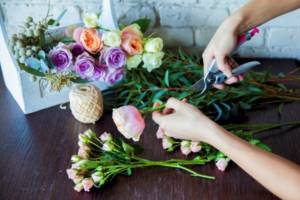
The simplest option is a boutonniere; even a preschooler can put together a small bouquet when collecting a bouquet of dandelions for mom. In this case, specialist instructions are not so necessary. The most difficult option is asymmetrical. The parallel method is used primarily to create tabletop compositions. Therefore, for training, it is worth focusing on the spiral technique - if everything is done correctly, the result will be a gorgeous bouquet.
How to assemble a boutonniere - all stages
A boutonniere is a traditional accessory worn by the groom, witnesses and wedding guests. Usually a boutonniere is assembled from flowers that are included in the bride's bouquet. But sometimes they do the opposite - they choose plants that contrast in color and variety. The most important rule is that in the center of the composition there is one large flower or floral branch, which can be supplemented with other plants.
Assembly rules:

- Preparing the main flower. Florists recommend placing the branch in cold water for 4 hours before starting work so that it remains fresh for as long as possible. The stem of the flower is cut obliquely, and its head is pierced with a thin wire vertically or horizontally, depending on how you decide to position the flower.
- If you do not use a special container for the flower, dip the cut in paraffin, or wrap it with a cotton pad dipped in water and secure it with transparent tape. The wire can be wrapped with colored paper or tape.
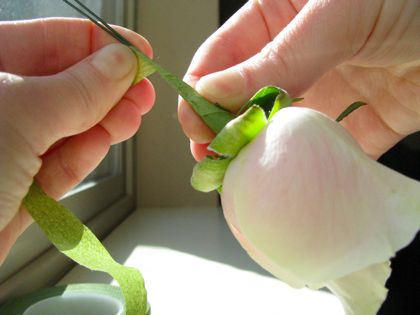
- Now we assemble the composition, placing small branches and buds just below the main flower. We also fix them with tape.
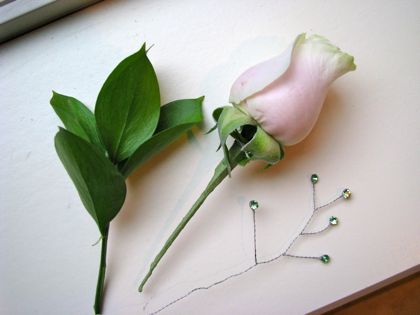
- Finally, we attach ribbons, beads and other decor.

Remember: the boutonniere must be flat on one side, otherwise you will not be able to beautifully attach it to the lapel of the jacket or on the wrist of the bridesmaid.
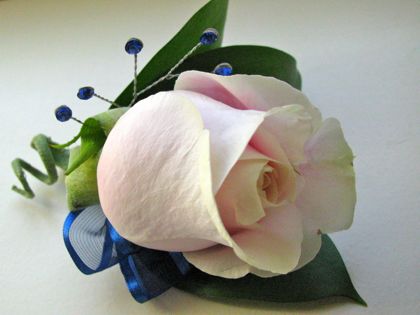
Spiral bouquet step by step
You can use any flowers; it is more convenient to choose those with long, even and dense stems - roses, chrysanthemums, daisies, etc. The sequence of actions is as follows:
- We take several peeled flowers and stack them with their tops. They must stand strictly vertically.
- Now we transfer the blank to the left hand - the flowers will remain in it until the very end of the process. With the right one we take a new flower and place it in front, slightly tilting it from left to right. We place the second flower from the back from right to left.
- We continue to lay the flowers diagonally, alternately in front and behind, and the larger the bouquet becomes, the stronger the angle of inclination should be.
Read more The art of making a wedding a wedding: exclusive floristry from professionals

- During the process, you can adjust the flowers and adjust the height of the heads; the main thing is to hold the bouquet firmly with your left hand until the spiral is fixed. Another important point is that with this assembly method the flowers touch only the stems.
- When using a spiral arrangement, greenery is usually added at the very end - as if wrapping a bouquet with it. Inside the composition there can only be greenery with small and narrow leaves, which does not clog the flowers themselves.
- If decor is used, it is also added to the bouquet in a spiral. You can do it another way: first secure the spiral bouquet with a tourniquet, then shake the bouquet to slightly loosen the spiral. And then carefully insert fern leaves and green twigs under the tourniquet.
- The assembled bouquet is firmly fixed again with tape, wire or a tourniquet, after which the excess ends are cut off with pruning shears. After this, the stems must be cut obliquely with a knife, otherwise the bouquet will not drink water and will not last long.
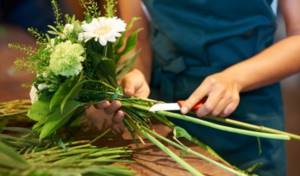
Professional florists do not recommend wrapping large round bouquets - and this is exactly the shape you will get - with mesh, film or paper. But if you have a small bouquet of 7-15 elements, decorating it with film or mesh is quite acceptable. It is very convenient to insert small gifts or cards into such a bouquet.
Assembling a parallel bouquet in several stages
Parallel bouquets, along with round ones, can often be seen at weddings. Often flowers are located not vertically, but horizontally. This is also an excellent option for decorating tables in a banquet hall or a wedding procession. It is very easy to assemble.
- Preparation. You will need flowers with large heads, sprigs of greenery or ferns, and any decorative elements. It is important that the flower stems are long enough, roses work well. They are processed as indicated above.
- Now we make a “ladder” of roses. We place them next to each other so that the head of each subsequent one is lower than the previous one. We wrap the stems one to one with jute rope or tape.
- We add greenery and decoration around the roses; you can add several branches with small flowers. But they should all be located below the main colors and not overlap them. In this option, greenery can be placed between rows of flowers.
- For stability, you can place the bouquet on a wire frame. Trim the stems so that they are of equal length. Finally, decorate the bouquet with ribbons and bows, if necessary, wrap it in cellophane.
Read more How to properly dry flowers for dry floristry?
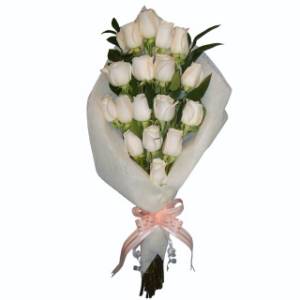
To make the parallel composition look harmonious, you should take approximately the same number of large flowers and decorative greenery or small flowers.
How to assemble an asymmetrical bouquet step by step
On the one hand, it is easiest to make such bouquets - there are no special rules, only the master’s imagination works. But on the other hand, this is where the whole difficulty lies. It is important to show maximum artistic taste and great accuracy so that it does not turn out too sloppy.
- We select flowers of different shapes and sizes; rejected branches with broken stems are suitable - they will find a place in an asymmetrical composition. All plants are prepared as described above.
- Now we make the top of the composition, that is, we place the longest flower or branch of greenery. Around it, diagonally or stepwise, we place other flowers and sprigs of greenery, securing everything with tape.
The basic rule of an asymmetrical bouquet is that only one element should protrude beyond the boundaries of the bouquet, otherwise the composition will look disheveled.
DIY floristry is a popular hobby today. Having mastered the basics, you will always be able to create exclusive and harmonious compositions to decorate your home or as gifts for friends. And if such a significant event in your life as a wedding is approaching, then floristry for beginners step by step will allow you to save on a fairly significant expense column.
How to hold a bouquet correctly
A cascading bouquet looks great when held with both hands at or just below your waist. Wearing it this way will draw the attention of those present to the flowers, and will also emphasize the elegance of the image. You can hold the bouquet with one hand. But such an accessory may be too heavy, so the first method is still preferable.
Bouquet of roses
A wedding bouquet of roses is an accessory that has become a classic. These flowers, long considered a symbol of tenderness and elegance, combine perfectly with other plants, allowing you to create unique compositions with them. The photos below demonstrate various options for bright and delicate bouquets of roses.
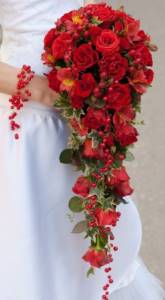
Compositions of lilies, orchids, peonies
Lilies and orchids are the favorite flowers of many girls. They are very often used when creating cascading bouquets. With the help of lilies and orchids you can make a successful classic composition or a composition combining several types of flowers.
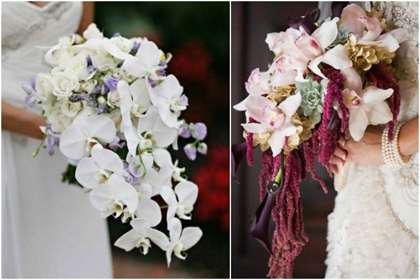
This bouquet will look great in wedding photos and videos.
Cascading compositions with peonies will add tenderness and naturalness to the bride's image. Bouquets with these flowers look airy. Peonies combine harmoniously with other flowers, all kinds of branches, herbs and leaves.
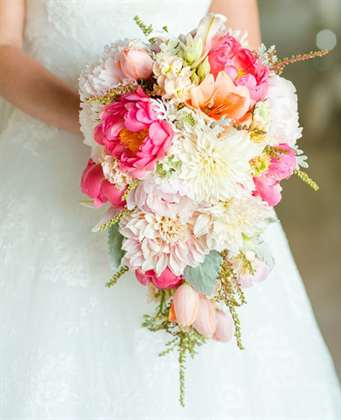
Short wedding dress
Small and elegant - this is how you can describe the perfect bouquet for a mini wedding dress in a nutshell. The flower arrangement in the hands of the bride is intended to emphasize her fragility and youth, because short dresses for weddings are usually chosen by young girls.
Mono-bouquets of small or very small flowers look very gentle and sophisticated: gypsophila, lilies of the valley, hydrangea, forget-me-nots, spray roses or carnations, wildflowers.
| photographer VICTORIA ISAEVA | photographer LOLA ALALYKINA |
| |
| photographer ALEXANDER KALININ | photographer MASLOVA VICTORIA |
